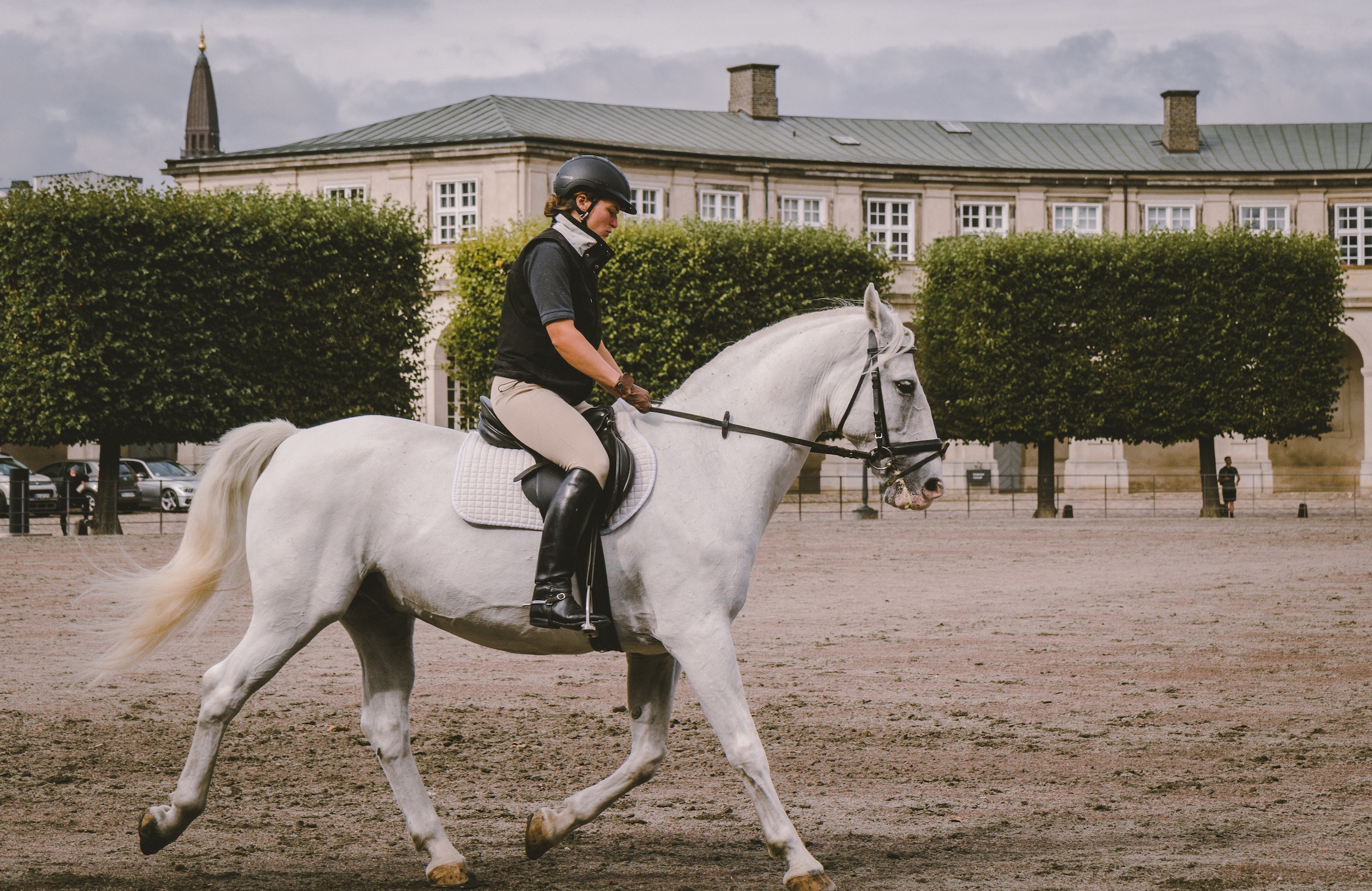You have heard that tight hips, sore groin and low back pain are often related to tension in the large hip flexors (aka the psoas muscles). BUT what you may not know is that the best psoas muscle “stretch” for equestrians is actually a Somatic Movement called Pandiculation!
In this article I’m going to teach you how easy and painless it can be to relieve tension in your hip flexors!

Horse riders are acutely aware of how important it is to have “open hips” and a flexible back to properly administer the aids when riding and to have clear communication with a horse. Cyclists know that tight hips get in the way of pushing power and endurance. Dancers are frequently afflicted by excruciating groin or low-back pain caused by tight and abused hip flexors.
And the rest of us, because we sit so much in our cars or at the computer, are also all too familiar with sore hips, shooting pains and aching backs… As you may have noticed, stretching only offers temporary relief from tension.
Tight psoas muscles can cause:
- groin pain
- low back pain
- a “sway-back”
- shortened stride
- reduced endurance/energy
- restricted range-of-motion
- difficulty swinging your leg into a saddle
- a “chair seat” when riding a horse
- tension or difficulty “opening the hips” (in rising trot, for example)
You can quickly and easily reset the resting tension levels in your psoas muscles using Hanna Somatics exercises and by giving your brain time to passively lengthen your muscles with a ‘motor plan.’
Ready to Relax your Hips with Easy Somatic Exercises?
This simple exercise is a great one to do before you mount your horse or climb on your bike. Use this anytime you have spent an extended period sitting, squatting or kneeling.
What is Tension?
Tension, put simply, is when a muscle or group of muscles are contracted. So a ‘tight’ muscle is a working muscle. Muscles are put to work anytime you want to move your body or when you respond to stress or trauma with involuntary reflexes.
When your muscles feel hard and sore, and you can’t seem to relax them no matter how hard you try… that’s chronic tension.
To say it another way, chronic tension is when your muscles are doing work for no reason, and seem ‘stuck’ or ‘tight.’ A total waste of energy.
What Causes Tension?
In a perfect world, your muscles should relax back into neutral after being put to work. But in the real-world, most of us end up carrying around some extra tension in the muscles we use most often. This tension accumulates a little bit at a time when we are stressed or doing repetitive motions, and becomes our baseline.
If a muscle is injured from over-work or being stretched too far, that causes the body to go into protective mode – like the fetal position – by shortening all the muscles around the injured area to ‘brace’ and protect it.
Any kind of repetitive motion, even when it isn’t causing over-work or injury, can also lead to tension in the psoas. Unfortunately, due to all the sitting we do, it’s inevitable that pretty much all of us have some degree of tension accumulating in our psoas muscles, every day.
This gradual accumulation of tension and chronic tension is also what defines our posture – it’s called Motor Sensory Amnesia, or MSA for short.
What Causes a Tight Psoas Muscle?
There are several causes of tight psoas muscles – and some of them are the typical hip flexor stretches that many people recommend! Over use, like intense physical training, or lack of use, like too much sitting, can also cause the psoas to become shortened and to feel tight.
Even something like sitting for extended periods is actually causing repeated contractions in the muscles that bend your body into the sitting position.
Over time, your nervous system learns to keep these muscles tight as it is constantly adapting to your ‘new normal.’ The result is chronic tension.
Why You Can’t Release Your Tight Psoas Muscle with Stretching:
All the muscles in your body that are used for movement are called skeletal muscles. Skeletal muscles can’t do anything without instructions. The instructions to either contract and ‘tighten’ or to lengthen and ‘relax’ come from your spinal cord or your brain.
So here’s the thing –
No matter how much you stretch your hip flexors, it can’t change the instructions being sent from the brain that maintain a muscles resting length aka resting muscle tonus.
Static stretching can loosen up the fascia and temporarily reduce the reaction of the ’stretch reflex’ but it has very little lasting effect on the tension level in the psoas muscle. Any length gained from static stretches usually wears off after a couple hours, and the nervous system always re-assert it’s instructions.
If a muscle was tight even when ‘at rest’ you can be sure that it was receiving instructions to contract.
How Do you Release or Relax the Psoas Muscle Without Stretching?
Most people suggest stretching, yoga poses, deep tissue massage or using trigger points to “release” the psoas. These can lead to temporary relief, but generally do not offer lasting effects, plus they are painful to do!
Because the nervous system is in control of the tension levels of the muscles, I find it more effective to go straight to the root of the problem – the messages coming from the brain and spinal cord.
So instead of doing traditional stretches, you can activate the reset button in your own nervous system by pandiculating.
Pandiculation – the Best Psoas Muscle ‘Stretch’ for Equestrians
Pandiculation is a natural polysynaptic reflex. It involves contracting a muscle or group of muscles by moving, and then slowly reducing the contractions back to neutral. You may not know it, but you have been doing pandiculations your whole life. You’ve seen a cat or dog pandiculate after waking from a nap. It looks like a full-body stretch, often accompanied by a yawn.
Pandiculation is nature’s method of preparing a body to move in a healthy, supple and functional way. It’s part of your parasympathetic nervous system, so it’s guaranteed to work for everybody. Because it’s a natural reflex, you already know how to do it. As we age and go through life, most of us do it less and less spontaneously…
Pssssst! Want the Secret to Becoming a Supple Rider?
Thomas Hanna, PhD, founder of Hanna Somatics, discovered that by intentionally performing a pandiculation, we trigger the same self-care effects as an involuntary pandiculation. When we do a voluntary pandiculation, we cause our brain to do its own diagnostic on the muscles involved.
Instead of using leverage or gravity to mechanically put the psoas muscle into a stretch, we can mindfully contract and de-contract the psoas muscles. Doing this very slowly gives the brain time to notice how well the muscles are functioning.
Once the brain notices there is extra tension in a muscle, it can reset the resting level of that muscle back to neutral. It does this automatically! This resetting is often described as a ‘release’ or a ‘relaxation’ by bodyworkers. Rather than releasing the tension itself, we are changing how the nervous system is controlling the muscle.
Once the muscle is no longer being told to be tight, it is able to go back to neutral, and it will do so automatically… 😉


